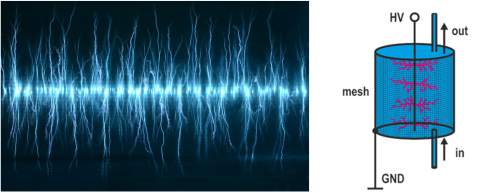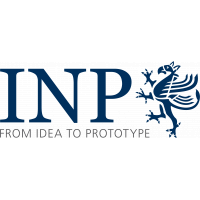Degradation of chemical contaminants up to mineralization and reduction of microbiological contamination by means of an electric discharge (plasma) directly in waste or process water

Figure 1: Photograph of an electric discharge in water. The plasma is generated at the inner electrode of the coaxial geom-etry and propagates outwards forming characteristic filaments.
Figure 2. Schematic drawing of the device for water treatment by electric discharges submerged in water.
Field of application of the technology, potential partners
Environment, bioeconomy, treatment of drinking, process and waste water
Description of the technology
The water passes through a coaxial electrode geometry to which nanosecond high voltages pulses with an amplitude of 80,000-100,000 V are applied. Due to the high electric field strength, the liquid is transformed into a plasma state, which spreads out in fine filaments in the liquid from the centre towards the outer electrode (see Figure 2).
Various reactive species (e.g. hydroxyl radical, atomic oxygen and hydrogen, superoxide and dissolved electron), UV-C radiation (with significant intensity even below 200 nm) and shockwaves are generated. The technology can be used to decompose recalcitrant chemical contaminants such as pharmaceutical residues (e.g. antibiotics, painkillers, hormones, X-ray contrast agents, etc.) and agrochemicals, as well as microbiological contaminants (e.g. Legionella, multi-resistant bacteria, etc.). As a by-product of the treatment, hydrogen is formed, which can be separated for further use.
Advantages of the technology
In particular, recalcitrant chemical compounds, which are not or only somewhat degraded by established water treatment methods can be effectively decomposed using the technology described above. Additional advantages of this technology are the easy handling and ‘on demand’ operation. In contrast to most established methods, no additional chemicals or catalysts are required.
Assessment of the market potential
In recent years, chemical pollutants have been detected more frequently in ground and surface waters, and in some cases even in drinking water. Many of these substances are released to rivers, lakes and groundwater reservoirs through industrial, municipal and hospital waste water.
Established water treatment technologies are often ineffective and only insufficiently decompose recalcitrant chemical pollutants.
With the system described above, very reactive chemical species, including hydroxyl radicals, are generated directly in the water by an electric discharge and thus directly interact with the pollutants contained in the water.
Due to the high demand for efficient processes for the degradation of recalcitrant compounds in water and its high adaptability to specific requirements, the plasma technology is considered to have a high market potential.
Possible areas of application that can be addressed with this technology include the treatment of drinking water as well as industrial, municipal and hospital waste water. The strength of this technology is the effective decomposition of recalcitrant organic pollutants and the inactivation of (multi-resistant) microbiological contamination.
Publications
- Decomposition of Pharmaceuticals by Pulsed Corona Discharges in Water Depending on Streamer Length, R. Banaschik, F. Koch, J. F. Kolb and K. Weltmann, IEEE Transactions on Plasma Science 42 (2014) 2736-2737
- Potential of pulsed corona discharges generated in water for the degradation of persistent pharmaceutical restudies, R. Banaschik, P. Lukes, H. Jablonowski, M. U. Hammer, K.-D. Weltmann and J. F. Kolb, Water Research 84 (2015) 127-135
- Fenton chemistry promoted by sub-microsecond pulsed corona plasmas for organic micropollutant degradation in water, R. Banaschik, P. Lukes, C. Miron, A. V. Pipa, K. Fricke, P. J. Bednarski and J. F. Kolb, Electrochimica Acta 245 (2017) 539-548
- Degradation and Intermediates of Diclofenac as Instructive Example for Decomposition of Recalcitrant Pharmaceuticals by Hydroxyl Radicals Generated with Pulsed Corona Plasma in Water, R. Banaschik, H. Jablonowski, P. J. Bednarski and J. F.Kolb, Journal of Hazardous Materials 342 (2018) 651-660
- Cylindrospermopsin is effectively degraded in water by pulsed corona-like and dielectric barrier discharges, M. Schneider, R. Rataj, J. F. Kolb and L. Bláha, Environmental Pollution 266 (2020) 115423
We are looking for
- Industrial partner for further development of the technology
- Industrial partner for applying for funding
- Licensee.
